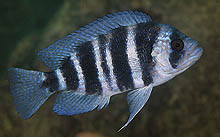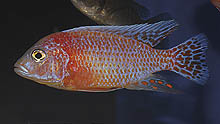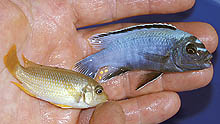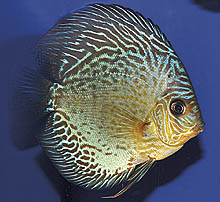WHAT'S NEW ACROSS THE WORLD
Select date in side bar to go a What's
New of previous issues
| What's New ©by
Laif DeMason
Winter is just beginning to set in and dedicated
hobbyists are spending more time with their aquarium setups and fishes.
With fewer activities outside during the cold months, more time can be
spent re-organizing and cleaning up our fish tanks. Usually after some
rearranging and overhauling in the aquarium room, hobbyists yearn to try
their hand at a new species. With world-wide economic problems, one
wonders if the purchase of new fishes can be justified. I say, you
bet it can! Everyone needs to keep their sanity and what better way than
to do that with cichlids? Hobbies are an important way for people in the
modern world to unwind from the stress and hectic ways of life. So
take the time needed for your hobby and, most importantly, enjoy!
Here’s “what’s new” on the cichlid scene: |
Lake Tanganyika
Interest in Tanganyikan cichlids seems to have increased over the last
half year within the Americas. General interest in all types of wild caught
as well as bred items is on the upswing, with large Tropheus drawing
special attention. Hobbyists are now starting to revisit some of the featherfins
as well as Cyprichromis species, which have not been as popular
until recently. Oddly, this recent popularity of Tanganyikan fishes in
America is not evident in Europe.
|
what's new: Lake Tanganyika
|

Several populations of tricolor-type Cyprichromis
leptosoma jumbo are found in different places around the Lake.
This so-called C. sp. ‘leptosoma jumbo’ yellowhead was collected
from Nkondwe Island near Kipili, Tanzania. |

Other species and color morphs of Cyprichromis
leptosoma are sometimes offered from breeders and wholesalers.
This blue one, called C. leptosoma “Mamalesa”, colors up at a small
size. |

Often sold as Xenotilapia spilopterus Kipili,
this yellow-finned fish is actually from a bit further north, near Sibwesa,
Tanzania and is usually available from bred sources. |

Plecodus straeleni is a mimic of Cyphotilapia frontosa.
It is rarely collected on purpose, but occasionally is exported.
Beware, this fish is a scale eater! Photo by A. Konings. |
Lake Malawi
The availability of wild caught cichlids from Malawi continues to be
strong. However, the prices of these items have increased somewhat. Until
recently, both exporters and some importers have absorbed the increases
associated with importing from the Lake. Even with newly imported Aulonocara
and new mbuna species with color morphs from different locations, hobbyists
are reluctant to buy at the new prices. There currently exists a fair back
log of wild items in stock at many wholesalers. Now large farm-bred Malawi
cichlids seem to be a great bargain.

Lethrinops species are now regularly imported
from Malawi. Several red types have gained popularity with specialists.
Here Lethrinops sp. ‘mbasi’ is seasonally available when they congregate
to breed. |

A newly collected afra-type, Cynotilapia sp.
‘chinyankwazi’ white top from Chinyankwazi Island. From this location,
this fish is found as a jumbo version. Photo by A. Konings. |

This species collected from the northern end of the
Lake, Lethrinops sp. ‘orange cap Nkhata’, has been imported from
Malawi. It is now bred by hobbyists in Europe. |

Bred and exported from Europe, this is another designer
strain of Malawi peacock. This strain is called Aulonocara Red Pearl
and seems to be similar to the Red Dragon strain, but colored with powder
blue. |

Exporters are often looking for new items and thus
sometimes collect species in alternate locations. Here is a recently
exported Cynotilapia sp. ‘lion’ from Sanga, Malawi. It is
similar to the well known Lion Cove version, but brighter. |

Never before commercially collected until recently,
Metriaclima
sp. ‘membe deep’ is found off Likoma Island in Malawi. Although this population
has been known for some time, it was never exported before because a similar
fish is readily available from Tanzania. |
West Africa
Inventories of wild fishes are at an all time high in many importers’
warehouses for items from West Africa. Exporters from Nigeria, Congo, and
Cameroon have been shipping as demand dictates, but due to higher landed
costs, there is still a large backlog of these fishes on hand in most importing
countries. Slowly, retailers and hobbyists alike will start to accept the
new prices, but the current economy makes the going slow.

Some of the first Pelvicachromis taeniatus exported
many years ago were the Nigerian Red type. They are still exported
and sold, although at a somewhat higher price now. |

Several different color morphs of P. taeniatus
are exported from Cameroon. Here is a female of a newer yellow
type called Nyete. |
Neotropics
As of this writing, the South American collecting season was in full
swing. In a few short weeks, the rains will be too heavy and collecting
will abate. Interest in Neotropical cichlids has increased along with the
current popularity (and breeding) of L-number Plecostomus-type catfishes.
Several oddities have also been collected and bred by adventurous hobbyists.

Occasionally available from specialty importers, Uaru
fernandezyepezi are still imported from Venezuela. Note the characteristic
white spotting on this individual. |

Originally collected in Uruguay by hobbyists, Australoheros
sp. ‘red breast Cuaro’ hails from Arroyo Cuaro Grande. Other species
of this genus have also been found. Photo by S. Jack. |

Many different discus strains are available from bred
sources, especially the Far East. Here is a beautiful snakeskin variety
in an adult size. |

Interesting, but aggressive and predatory, the spot-lipped
pike, Crenicichla celidochilus, has a dummy eye spot on its lip!
This fish was collected from Rio Cuareim, Uruguay. Photo by S. Jack. |
Select date in side bar to go a What's
New of previous issues
|















